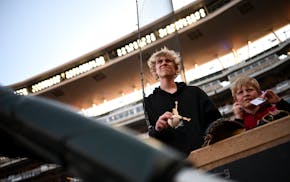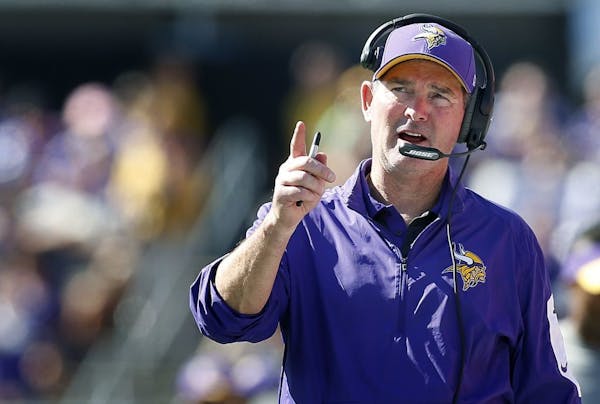A few minutes after the skies opened in Eden Prairie on Thursday afternoon, Vikings offensive line coach Jeff Davidson surveyed his players without giving the brief downpour much thought. Standing there in a dark gray rain suit, the former NFL lineman looked like he could still strap on a helmet and give somebody the business.
Before the five linemen hunched over in front of him fired out of their stances and into a synchronized blocking pattern, Davidson gestured, pointed and drew imaginary lines with his hands. He looked like he was conducting an orchestra. And he kind of is.
For Teddy Bridgewater and Adrian Peterson to make sweet, sweet music, he needs all of his linemen to be in harmony. One cacophonous sequence can derail a drive.
And right now, this conductor is working with the equivalent of two second-chair performers. Only one member of his first-string quintet was a highly coveted player out of an NFL Juilliard. And his one-time bassoon player is now holding a clarinet.
Alongside left tackle Matt Kalil, the fourth overall pick in the 2012 draft, the Vikings are relying on a group of later-round picks, undrafted linemen and a couple of players at new positions to protect their first-round quarterback and create running room for their $15 million running back.
The organization, which has a history of discovering hidden gems, believes it can keep them coming. But due to injuries and other circumstances, poor offensive line play has prevented the Vikings from taking a leap forward as an offense this season.
The line will get one of its toughest tests of the season today against the St. Louis Rams, who, led by former first-round picks Robert Quinn and Aaron Donald, rank second in the NFL in sacks.
"I'd be the first to tell you that we're still behind the curve," Davidson said. "We've got a long way to go in a short period of time. We've got a lot of work ahead of us."
Late round finds
After the 2014 season, one in which Vikings quarterbacks were sacked 51 times and their running backs averaged fewer than 4 yards per carry, reinforcements on the offensive line was arguably their biggest need. Kalil really struggled, veteran left guard Charlie Johnson had to be let go (and was) and an infusion of young talent was needed.
But their only move in free agency was re-signing valuable backup Joe Berger, who is now starting. And in the draft, General Manager Rick Spielman, who declined to be interviewed for this story, used his first three draft picks on defensive players.
Finally, in the fourth round, the Vikings selected T.J. Clemmings, a former defensive lineman at Pitt who quickly blossomed into one of the top right tackles in college football. In the sixth, they took Oklahoma tackle Tyrus Thompson. Austin Shepherd, a two-year starter at Alabama, was one of their seventh-round picks.
"There were guys that we would have drafted early that got picked before we could pick them. So we basically went with the best players available as far as that," coach Mike Zimmer said. "[Our drafting philosophy] doesn't preclude us from taking high draft picks. That's just how it worked out — since I've been here, anyway."
But the philosophy of waiting to draft offensive linemen, especially on the interior, predated Zimmer. Since 2007, the Vikings have drafted 12 linemen. Only two of them were selected in the first three rounds. They were Kalil and right tackle Phil Loadholt, who suffered a season-ending torn Achilles' in August.
The two characteristics the Vikings say they covet most are toughness and intelligence, which explains why they have used their early picks on athletes at other positions.
The Vikings have whiffed on late picks such as Jeff Baca, Chris DeGeare and now Thompson, who was cut at the end of the preseason. But injured center John Sullivan and left guard Brandon Fusco were sixth-round picks who became quality starters, just like the now-retired Matt Birk did after going 173rd overall in 1998.
"They've done a pretty good job with Sullivan and Fusco," said former NFL offensive lineman Ross Tucker, a television analyst for NBC Sports Network. "I'd say if you look around the league, the Vikings are probably doing a little better than some of the other teams are."
Work in progress
This year, though, the offensive line has performed below even modest expectations.
Through seven games, Bridgewater has been pressured on 45.4 percent of his dropbacks, second-most in the NFL, according to Pro Football Focus. And Vikings running backs, usually Peterson, have been stopped at or short of the line of scrimmage on 23 percent of their runs, according to Football Outsiders.
Injuries have been a factor. Sullivan and Loadholt were lost in the preseason, as was backup tackle Carter Bykowski, forcing them to plug in Berger at center and Clemmings, who has been up and down in his rookie season, at right tackle.
The Vikings moved Fusco, who missed most of the 2014 season because of a torn pectoral muscle, from right guard to left. He has struggled with that transition, but Kalil has looked a lot better this season with Fusco lined up next to him.
Right guard Mike Harris, who went undrafted and had been a tackle for his entire football life before this summer, has arguably been their best blocker.
They are not the only offensive line that has struggled, though. According to ESPN the Magazine, quarterbacks around the NFL are getting sacked more frequently than in recent years, running backs are averaging fewer rushing yards before first contact and offensive linemen are committing more penalties than last season.
The Vikings line had one of its best performances of the season in last week's 23-20 victory at Chicago. All five linemen have started every game, and they feel like they will continue to reap the benefits of that continuity going forward.
"We're definitely jelling," said Harris, who was acquired in a trade before the 2014 season. "We know how to get the job done. We've just got to go out there and do it."
Onus on coaching
Of the 11 linemen on the active roster or practice squad, five were not drafted and four were selected in the fifth round or later. Backup center Nick Easton is on his third team in as many months. Guard Isame Faciane, who made the practice squad over Thompson, was converted from defensive line to offense in the offseason.
Whether all that is by design or not, it puts the pressure on Davidson and his assistant, former NFL lineman Hank Fraley, to try to develop the next Sullivan or Fusco.
"We'll end up taking anybody that they give us," said Davidson, who was hired in 2011. "And our approach has been that once a guy gets here, we assume they know nothing."
Davidson said the Vikings "start with ground zero" with new players. They teach the linemen, whether they are a top-five pick out of powerhouse USC such as Kalil or a veteran journeyman such as Berger, their way of doing things — their preferred stance, their style of footwork and hand placement, their blocking schemes.
So why did Sullivan and Fusco make it when other late-round picks couldn't stick?
"No matter when a guy is drafted or how we obtained the guy, we always look for having a [baseline] for that player and each day we try to improve," Davidson said. "If you're not a starter, you better be developing into one or we're probably going to have to move on to someone else."
Finding gems
The Vikings are not alone in choosing to predominantly draft and develop late-round picks. Four other teams have also drafted only two linemen in the first three rounds since 2007. Two of them, Green Bay and New England, have won Super Bowls during that span.
"That's what I would do," Tucker said. "If you could have continuity and chemistry and you can give those late-round picks a year or two to get ready, that's what I would do."
Of the five teams who have taken that approach, though, only Philadelphia ranks in the top 10 of Pro Football Focus' line rankings for 2015.
Dallas, which tops the list, has three recent first-round picks up front. Second-ranked Cleveland starts two first-round picks and a pair of second-round picks, plus the Browns also have 2015 first-rounder Cameron Erving sitting on their bench. Cincinnati, which ranks eighth, drafted linemen with its top two picks even though the Bengals already had a quality quintet.
Meanwhile, Atlanta, which ranks third in PFF's rankings, has patched together an effective unit with castaways after most of the Falcons' high picks fizzled out.
"Watching offensive lines throughout the league, there are some guys that aren't as talented by themselves but as a group they play good," Zimmer said. "The chemistry with those guys, it's a lot like the secondary. You have to all be on the same page."
Just like a conductor and an orchestra. If the players aren't in sync, it doesn't matter where they came from or how they got inside the auditorium.
"There's no doubt about it," Davidson said.
Webb Simpson offers to resign from PGA Tour board. But only if McIlroy replaces him, AP source says

Live: Twins vs. White Sox. Follow the action on Gameview
![Glen and Becky Taylor during game 1 on Saturday, April 20, 2024, at Target Center in Minneapolis, Minn. ] CARLOS GONZALEZ • carlos.gonzalez@startri](https://arc.stimg.co/startribunemedia/X74AVHP3ZBD4TPPPDJTNX5LN6M.jpg?h=91&w=145&fit=crop&bg=999&crop=faces)
Gameview: Wolves vs. Suns in Game 2. Up-to-the-second updates here.
Paris main airport unveils new baggage handling system ahead of the 2024 Olympics

